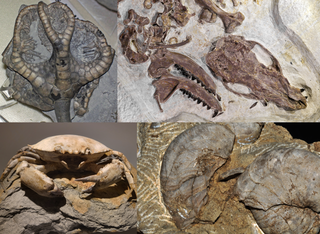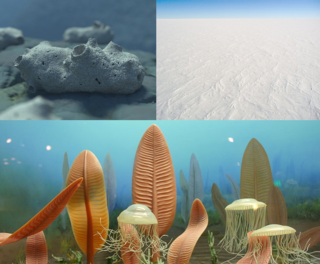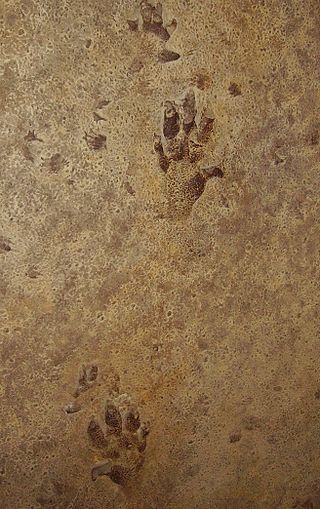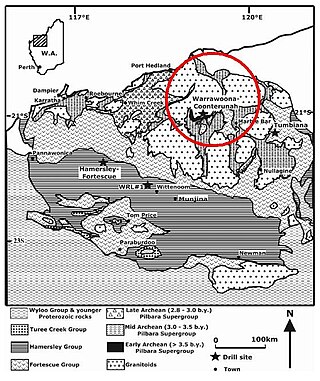
The Ediacaran is a geological period of the Neoproterozoic era that spans 96 million years from the end of the Cryogenian period at 635 Mya to the beginning of the Cambrian period at 538.8 Mya. It is the last period of the Proterozoic eon as well as the last of the so-called "Precambrian supereon", before the beginning of the subsequent Cambrian period marks the start of the Phanerozoic eon, where recognizable fossil evidence of life becomes common.
The timeline of the evolutionary history of life represents the current scientific theory outlining the major events during the development of life on planet Earth. Dates in this article are consensus estimates based on scientific evidence, mainly fossils.

A fossil is any preserved remains, impression, or trace of any once-living thing from a past geological age. Examples include bones, shells, exoskeletons, stone imprints of animals or microbes, objects preserved in amber, hair, petrified wood and DNA remnants. The totality of fossils is known as the fossil record.

The Neoproterozoic Era is the unit of geologic time from 1 billion to 538.8 million years ago.
The Precambrian is the earliest part of Earth's history, set before the current Phanerozoic Eon. The Precambrian is so named because it preceded the Cambrian, the first period of the Phanerozoic Eon, which is named after Cambria, the Latinised name for Wales, where rocks from this age were first studied. The Precambrian accounts for 88% of the Earth's geologic time.

The Proterozoic is the third of the four geologic eons of Earth's history, spanning the time interval from 2500 to 538.8 Mya, the longest eon of the Earth's geologic time scale. It is preceded by the Archean and followed by the Phanerozoic, and is the most recent part of the Precambrian "supereon".

Acritarchs are organic microfossils, known from approximately 1800 million years ago to the present. The classification is a catch all term used to refer to any organic microfossils that cannot be assigned to other groups. Their diversity reflects major ecological events such as the appearance of predation and the Cambrian explosion.

The Paleoproterozoic Era is the first of the three sub-divisions (eras) of the Proterozoic eon, and also the longest era of the Earth's geological history, spanning from 2,500 to 1,600 million years ago (2.5–1.6 Ga). It is further subdivided into four geologic periods, namely the Siderian, Rhyacian, Orosirian and Statherian.

Dickinsonia is a genus of extinct organism, most likely an animal, that lived during the late Ediacaran period in what is now Australia, China, Russia and Ukraine. It is one of the best known members of the Ediacaran biota. The individual Dickinsonia typically resembles a bilaterally symmetrical ribbed oval. Its affinities are presently unknown; its mode of growth has been considered consistent with a stem-group bilaterian affinity, though various other affinities have been proposed. The discovery of cholesterol molecules in fossils of Dickinsonia lends support to the idea that Dickinsonia was an animal, though these results have been questioned.

A trace fossil, also known as an ichnofossil, is a fossil record of biological activity by lifeforms but not the preserved remains of the organism itself. Trace fossils contrast with body fossils, which are the fossilized remains of parts of organisms' bodies, usually altered by later chemical activity or mineralization. The study of such trace fossils is ichnology and is the work of ichnologists.

Vendobionts or Vendozoans (Vendobionta) are a proposed very high-level, extinct clade of benthic organisms that made up of the majority of the organisms that were part of the Ediacaran biota. It is a hypothetical group and at the same time, it would be the oldest of the animals that populated the Earth about 580 million years ago, in the Ediacaran period. They became extinct shortly after the so-called Cambrian explosion, with the introduction of fauna formed by more recognizable groups and more related to modern animals. It is very likely that the whole Ediacaran biota is not a monophyletic clade and not every genus placed in its subtaxa is an animal.

Rangea is a frond-like Ediacaran fossil with six-fold radial symmetry. It is the type genus of the rangeomorphs.

Aspidella is an Ediacaran disk-shaped fossil of uncertain affinity. It is known from the single species A. terranovica.

Paleobiology is an interdisciplinary field that combines the methods and findings found in both the earth sciences and the life sciences. Paleobiology is not to be confused with geobiology, which focuses more on the interactions between the biosphere and the physical Earth.

The Sarmatian Craton or Sarmatia is the southern segment/region of the East European Craton or Baltica, also known as Scythian Plateau. The craton contains Archaean rocks 2.8 to 3.7 billion years old (Ga). During the Carboniferous the craton was rifted apart by the Dnieper-Donets rift. As a result, geomorphologically the cratonic area is split by the Donbas Fold Belt, also known as a part of the large Pripyat-Dniepr-Donets aulacogen, which transects Sarmatia, dividing it into the Ukrainian Massif or shield on the southwest and the Voronezh Massif to the northeast.

The Ediacaranbiota is a taxonomic period classification that consists of all life forms that were present on Earth during the Ediacaran Period. These were enigmatic tubular and frond-shaped, mostly sessile, organisms. Trace fossils of these organisms have been found worldwide, and represent the earliest known complex multicellular organisms. The term "Ediacara biota" has received criticism from some scientists due to its alleged inconsistency, arbitrary exclusion of certain fossils, and inability to be precisely defined.
Ediacaran type preservation relates to the dominant preservational mode in the Ediacaran period, where Ediacaran organisms were preserved as casts on the surface of microbial mats.

The Warrawoona Group is a geological unit in Western Australia containing putative fossils of cyanobacteria cells. Dated 3.465 Ga, these microstructures, found in Archean chert, are considered to be the oldest known geological record of life on Earth.

The earliest known life forms on Earth may be as old as 4.1 billion years old according to biologically fractionated graphite inside a single zircon grain in the Jack Hills range of Australia. The earliest evidence of life found in a stratigraphic unit, not just a single mineral grain, is the 3.7 Ga metasedimentary rocks containing graphite from the Isua Supracrustal Belt in Greenland. The earliest direct known life on land may be stromatolites which have been found in 3.480-billion-year-old geyserite uncovered in the Dresser Formation of the Pilbara Craton of Western Australia. Various microfossils of microorganisms have been found in 3.4 Ga rocks, including 3.465-billion-year-old Apex chert rocks from the same Australian craton region, and in 3.42 Ga hydrothermal vent precipitates from Barberton, South Africa. Much later in the geologic record, likely starting in 1.73 Ga, preserved molecular compounds of biologic origin are indicative of aerobic life. Therefore, the earliest time for the origin of life on Earth is at least 3.5 billion years ago, possibly as early as 4.1 billion years ago — not long after the oceans formed 4.5 billion years ago and after the formation of the Earth 4.54 billion years ago.

















